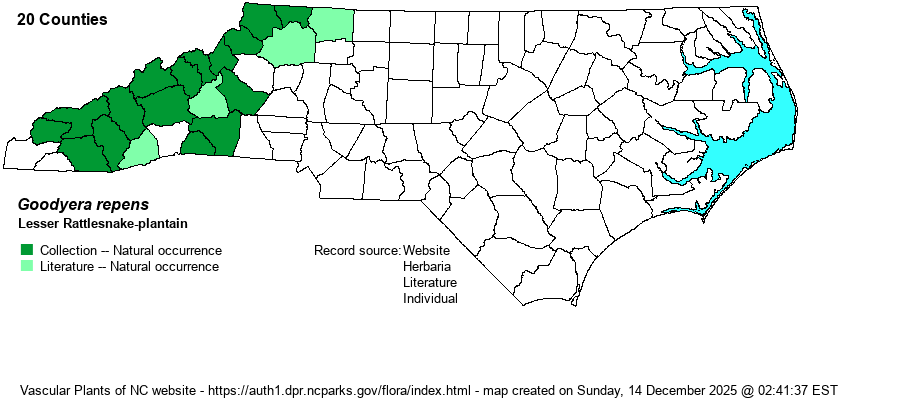| Author | (L.) R. Brown | |
| Distribution | Present over essentially all of the Mountains, and sparingly into the western Piedmont foothills/monadnocks. It does not occur at lower elevations (below 1000 feet).
This is a circumboreal species, found across most of Canada, south to NY and MN in the eastern US, and then south in the Appalachians to southern NC. It is apparently absent in northern GA.
| |
| Abundance | Rare to uncommon in the Mountains, and very rare to rare in the highest parts of the Piedmont. This is a Watch List species in the state. | |
| Habitat | This species has much more restrictive habitats than its "cousin" -- Downy Rattlesnake-plantain (Goodyera pubescens). It is limited mainly to moist, shaded places beneath conifers or evergreen shrubs in cool micro-habitats, such as wooded slopes, ravines, and near streams. With the demise of Eastern Hemlock (Tsuga canadensis) in our mountains, this loss may have a negative impact on the distribution and abundance of this orchid. It grows well under stands of Rosebay Rhododendron (Rhododendron maximum), which thankfully is abundant and not obviously in decline in the mountains and foothills. It can also be found growing with various mosses in damp shady places. | |
| Phenology | Blooms from June to September, and fruits shortly after flowering. | |
| Identification | This is a rather "tiny" orchid, though thankfully it has quite striking basal, evergreen leaves. Each plant has a few elliptical, entire dark blue-green leaves that lie nearly flat on the ground; each leaf (mainly only 1 inch long) has strong and wide white veins, not only the central one but the lateral veins are nearly as widely colored in white as is the central vein. The related Downy Rattlesnake-plantain has larger basal leaves that have a wide white central vein but very narrow side veins. In flower, G. repens has a short stalk often just 6 inches tall, and the numerous small white ball-shaped flowers grow on a single side of the stalk. As with the larger species, the plant is more easily spotted in winter when there is less herbaceous plant competition present. It is scarce enough that you will not likely run across it on most mountain walks, and you need to be quite watchful for it when you are in cool, moist, and deeply shaded evergreen places. | |
| Taxonomic Comments | Currently, there seem to be no varieties assigned by most references. However, decades ago there were, and RAB (1968) indicated that var. ophioides was the one present in NC.
| |
| Other Common Name(s) | Dwarf Rattlesnake-plantain, Lesser Rattlesnake-orchid, Creeping Lady's-tresses. The last is a very poor name, as "lady's-tresses" are all in the genus Spiranthes. | |
| State Rank | S2S3 | |
| Global Rank | G5 | |
| State Status | W1 | |
| US Status | | |
| USACE-agcp | UPL link |
| USACE-emp | FACU link |

